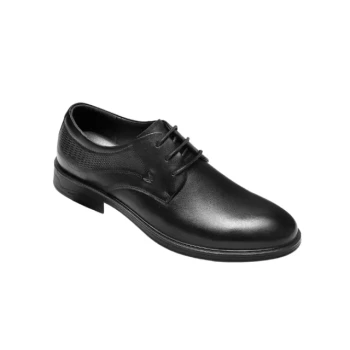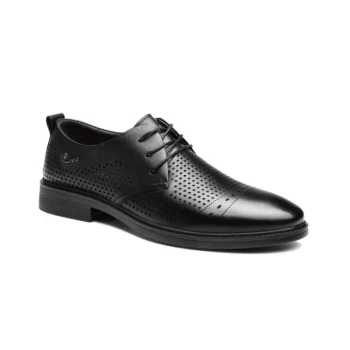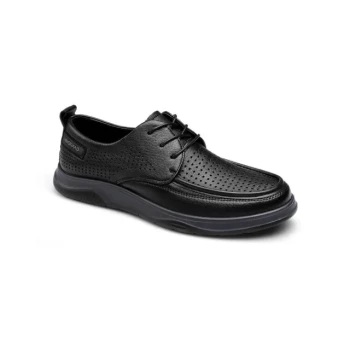The defining difference between Derby and Oxford shoes is their lacing system. An Oxford features a "closed" lacing system where the eyelet facings are stitched underneath the front part of the shoe, creating a sleek, clean appearance. In contrast, a Derby uses an "open" lacing system, where the eyelet facings are stitched on top, forming two visible flaps that allow for more flexible adjustment.
The choice between an Oxford and a Derby is not merely stylistic; it's a decision rooted in the shoe's fundamental construction. This construction directly dictates the shoe's formality, comfort, and versatility.
The Defining Feature: Open vs. Closed Lacing
The single most important distinction between these two classic shoe styles is how the quarters (the side pieces containing the lace eyelets) are attached to the vamp (the front section covering the foot).
The Oxford's "Closed" Lacing
An Oxford has its eyelet facings sewn under the vamp.
This construction pulls the shoe together neatly, creating a seamless and elegant profile with a V-shaped opening for the laces. This clean line is what gives the Oxford its distinctly formal character.
The Derby's "Open" Lacing
A Derby has its quarters sewn on top of the vamp.
This creates two flaps of leather that sit atop the shoe's tongue, which is part of the vamp itself. This "open" construction is visually more prominent and is the source of the Derby's unique characteristics.
How Construction Impacts Fit and Comfort
The lacing system isn't just for looks; it fundamentally changes how the shoe feels and fits on your foot.
Why Derbies Accommodate More Foot Shapes
The open-lacing flaps on a Derby allow for greater adjustability.
This makes them significantly more comfortable for individuals with a high instep (or high arches) and wider feet, as the lacing can be loosened or tightened more expansively.
The Sleek, Snug Fit of an Oxford
The closed-lacing system of an Oxford offers less flexibility.
While this results in a snug and contoured fit for a standard foot, it can feel restrictive for those with higher arches. The shoe is designed to hug the foot with minimal excess space.
Understanding the Trade-offs: Formality and Versatility
The structural differences between the two shoes directly inform when and where you should wear them. This is the most critical factor in your decision.
The Oxford: The Gold Standard of Formality
The Oxford's sleek, uninterrupted silhouette makes it the quintessential dress shoe.
It is the default choice for business suits, formal occasions, and black-tie events. A black patent leather Oxford, for example, is the correct shoe to wear with a tuxedo.
The Derby: The Versatile Workhorse
The Derby's slightly more robust and open appearance positions it as a more versatile shoe.
It is perfectly at home with a suit but can also be dressed down effortlessly with chinos, trousers, or even dark denim. This adaptability makes it an excellent foundation for a "smart casual" wardrobe.
Making the Right Choice for Your Wardrobe
Your decision should be guided by your specific needs for formality, comfort, and versatility.
- If your primary focus is maximum formality: Choose the Oxford. Its clean lines are the undisputed standard for business professional and formal attire.
- If your primary focus is versatility and comfort: Choose the Derby. It bridges the gap between formal and casual and offers a more accommodating fit for various foot shapes.
- If you are building a foundational shoe collection: Start with a black cap-toe Oxford for your most formal needs and a brown or oxblood Derby for everything else.
Understanding this core difference empowers you to select the right shoe for any occasion with confidence.
Summary Table:
| Feature | Oxford Shoe | Derby Shoe |
|---|---|---|
| Lacing System | Closed (facings under vamp) | Open (facings on top of vamp) |
| Formality | High (formal/business) | Versatile (smart casual to business) |
| Fit & Comfort | Snug fit, best for standard feet | Adjustable, ideal for high insteps/wide feet |
| Best For | Suits, black-tie events, professional settings | Chinos, trousers, denim, versatile daily wear |
Ready to Elevate Your Footwear Collection?
As a large-scale manufacturer, 3515 produces a comprehensive range of high-quality footwear for distributors, brand owners, and bulk clients. Whether you need the formal elegance of Oxfords or the versatile comfort of Derbies, our production capabilities encompass all types of shoes and boots to meet your exact specifications.
Let's discuss your next project. Contact our team today to explore our manufacturing solutions and bring superior footwear to your market.
Related Products
- Wholesale Training Shoes with Dial Lacing System Custom OEM Manufacturing
- Wholesale Leather Derby Shoes Manufacturer | Customizable Business & Dress Footwear
- Custom Breathable Perforated Leather Derby Shoes for Wholesale & Brands
- Wholesale Leather Derby Dress Shoes Custom Manufacturer for Brands
- Wholesale Breathable Perforated Leather Derby Dress Shoes for Custom Brands
People Also Ask
- Can Blucher shoes have decorative elements? Unlock the Versatility of Brogue Details
- How have sneaker brands incorporated camouflage patterns? From Military to Streetwear Style
- Why are lace-up shoes generally preferred over slip-ons? Unlock Superior Support & Stability
- What is a Flyknit shoe? The Ultimate Guide to Seamless, Lightweight Performance
- Does exercising with a friend or partner enhance safety? Unlock the 'Buddy System' Benefits



















